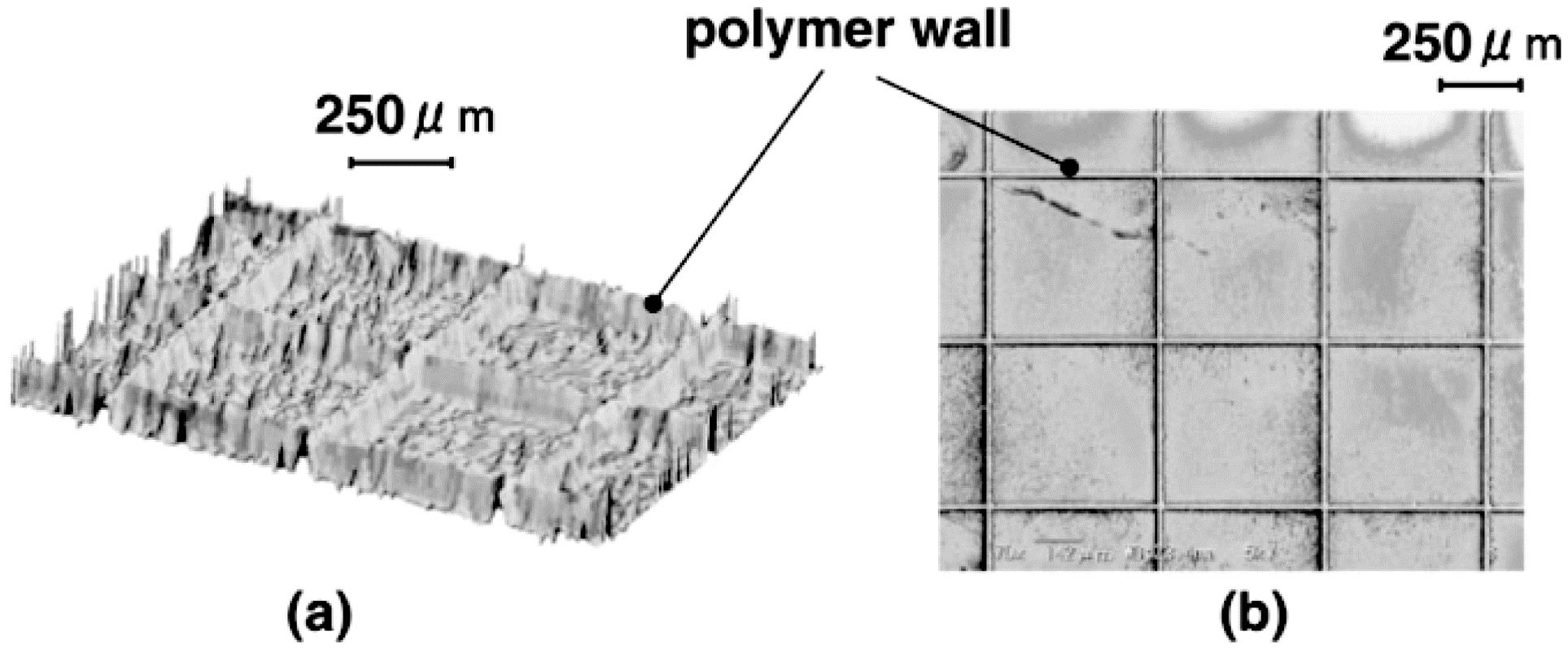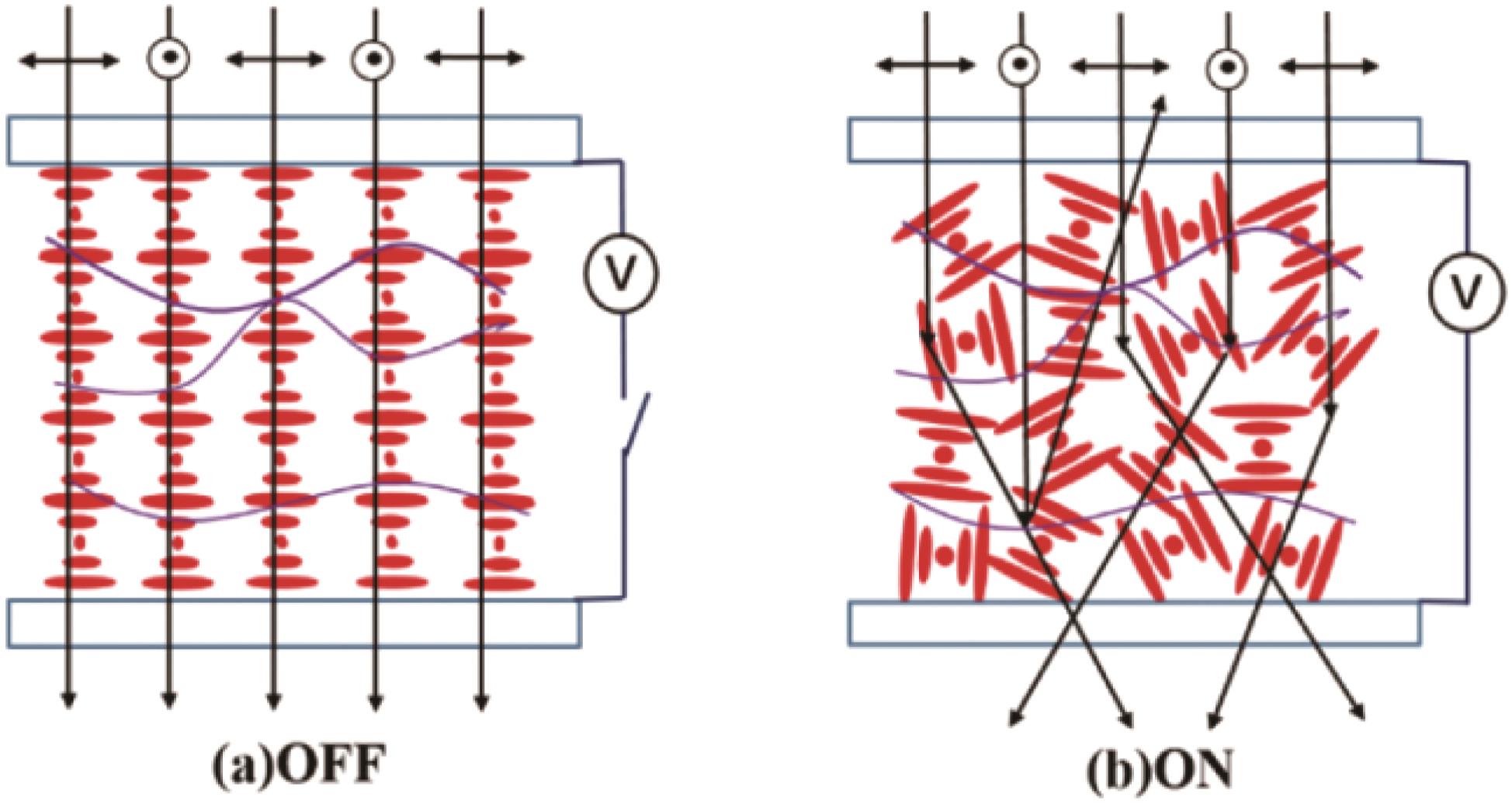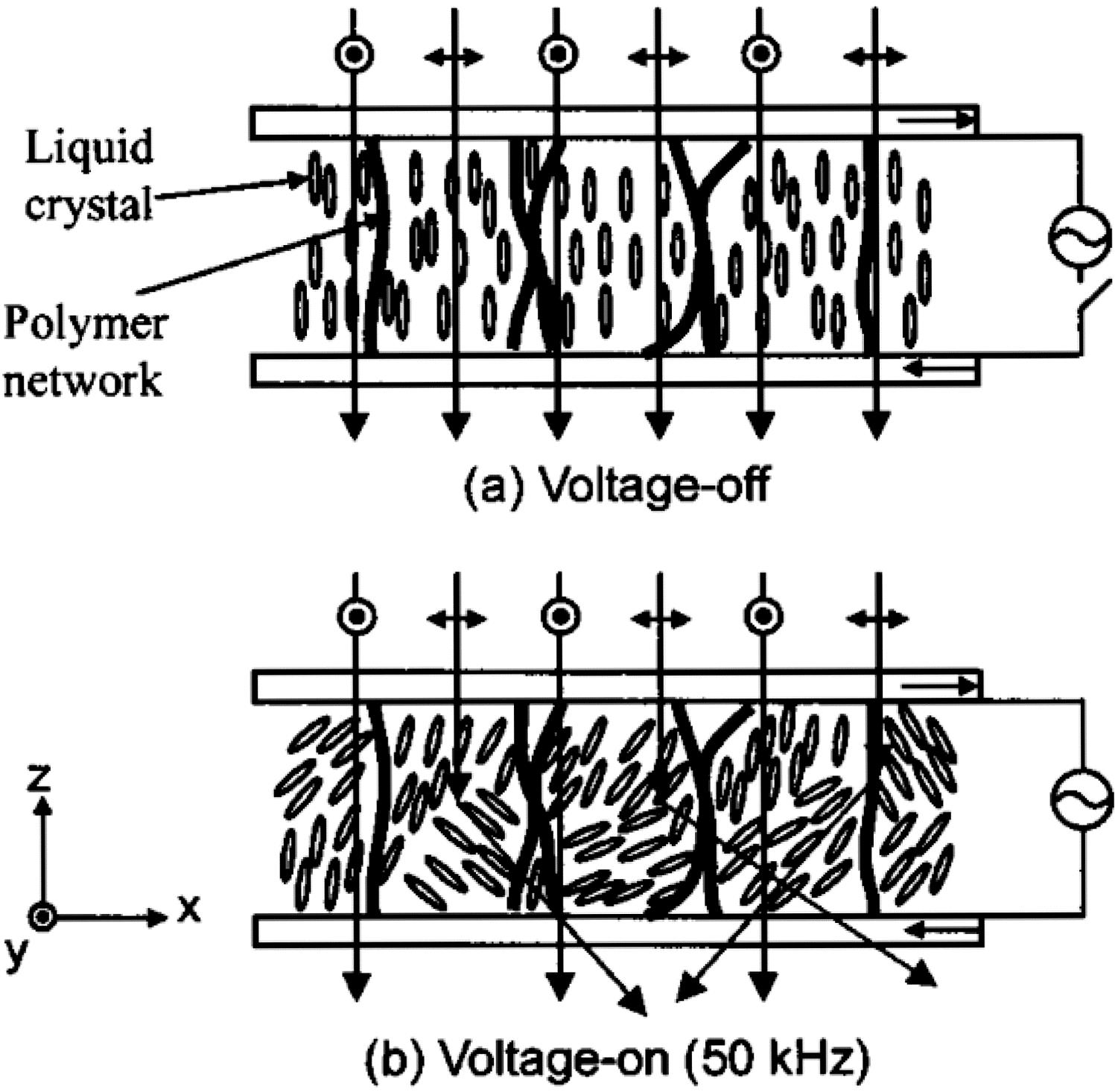
应用化学 ›› 2021, Vol. 38 ›› Issue (10): 1213-1225.DOI: 10.19894/j.issn.1000-0518.210373
液晶/高分子复合材料及其在反式电控调光膜中的应用研究进展
邹呈1, 高延子1, 于美娜1, 肖久梅2, 张兰英, 杨槐1( )
)
- 1北京科技大学北京材料基因工程高精尖创新中心,北京科技大学新材料技术研究院,北京 100083
2北京科技大学数理学院,北京 100083
3北京大学材料科学与工程学院,北京 100083
-
收稿日期:2021-07-29接受日期:2021-09-01出版日期:2021-10-01发布日期:2021-10-15 -
通讯作者:杨槐 -
基金资助:国家自然科学基金(11280232);国家重点研发计划(2020YFE0100200)
Recent Advances in Liquid Crystal/Polymer Composites and Their Applications in Reverse⁃mode Electrically Switchable Light⁃transmittance Controllable Films
Cheng ZOU1, Yan-Zi GAO1, Mei-Na YU1, Jiu-Mei XIAO2, Lan-Ying ZHANG, Huai YANG1( )
)
- 1Beijing Advanced Innovation Center for Materials Genome Engineering & Institute for Advanced Materials and Technology,University of Science and Technology Beijing,Beijing 100083,China
2School of Mathematics and Physics,University of Science and Technology Beijing,Beijing 100083,China
3School of Materials Science and Engineering, Peking University, Beijing 100871, China
-
Received:2021-07-29Accepted:2021-09-01Published:2021-10-01Online:2021-10-15 -
Contact:Huai YANG -
About author:yanghuai@pku.edu.cn
-
Supported by:National Natural Science Foundation of China(11280232);the National Key R&D Program of China(2020YFE0100200)
摘要:
液晶材料作为信息化时代的基础材料已经在显示领域实现了广泛的商业化应用。 液晶/高分子复合材料既具有液晶材料的各向异性及外场响应特性,还具有高分子易加工成本低等特点,可以加工成大面积柔性调光薄膜,因而在建筑玻璃、智能车窗中具有广阔的应用前景。 此外,液晶与高分子材料之间的相互作用会对液晶小分子取向产生影响,液晶小分子也可以作为模板控制高分子网络的形成的方向,使复合材料薄膜实现一些新的功能和特性,因此激发了大量国内外学者的研究兴趣。 本文将详细介绍液晶/高分子复合材料的类型、特点、在调光膜中的应用及反式电控调光膜的最新研究进展。 在此框架下,将重点阐述基于液晶/高分子复合材料的反式电控调光膜的一些新的制备方法,同时介绍目前存在的挑战及需要解决的问题,最后对反式电控调光膜近期可能实现的应用进行了展望。
中图分类号:
引用本文
邹呈, 高延子, 于美娜, 肖久梅, 张兰英, 杨槐. 液晶/高分子复合材料及其在反式电控调光膜中的应用研究进展[J]. 应用化学, 2021, 38(10): 1213-1225.
Cheng ZOU, Yan-Zi GAO, Mei-Na YU, Jiu-Mei XIAO, Lan-Ying ZHANG, Huai YANG. Recent Advances in Liquid Crystal/Polymer Composites and Their Applications in Reverse⁃mode Electrically Switchable Light⁃transmittance Controllable Films[J]. Chinese Journal of Applied Chemistry, 2021, 38(10): 1213-1225.
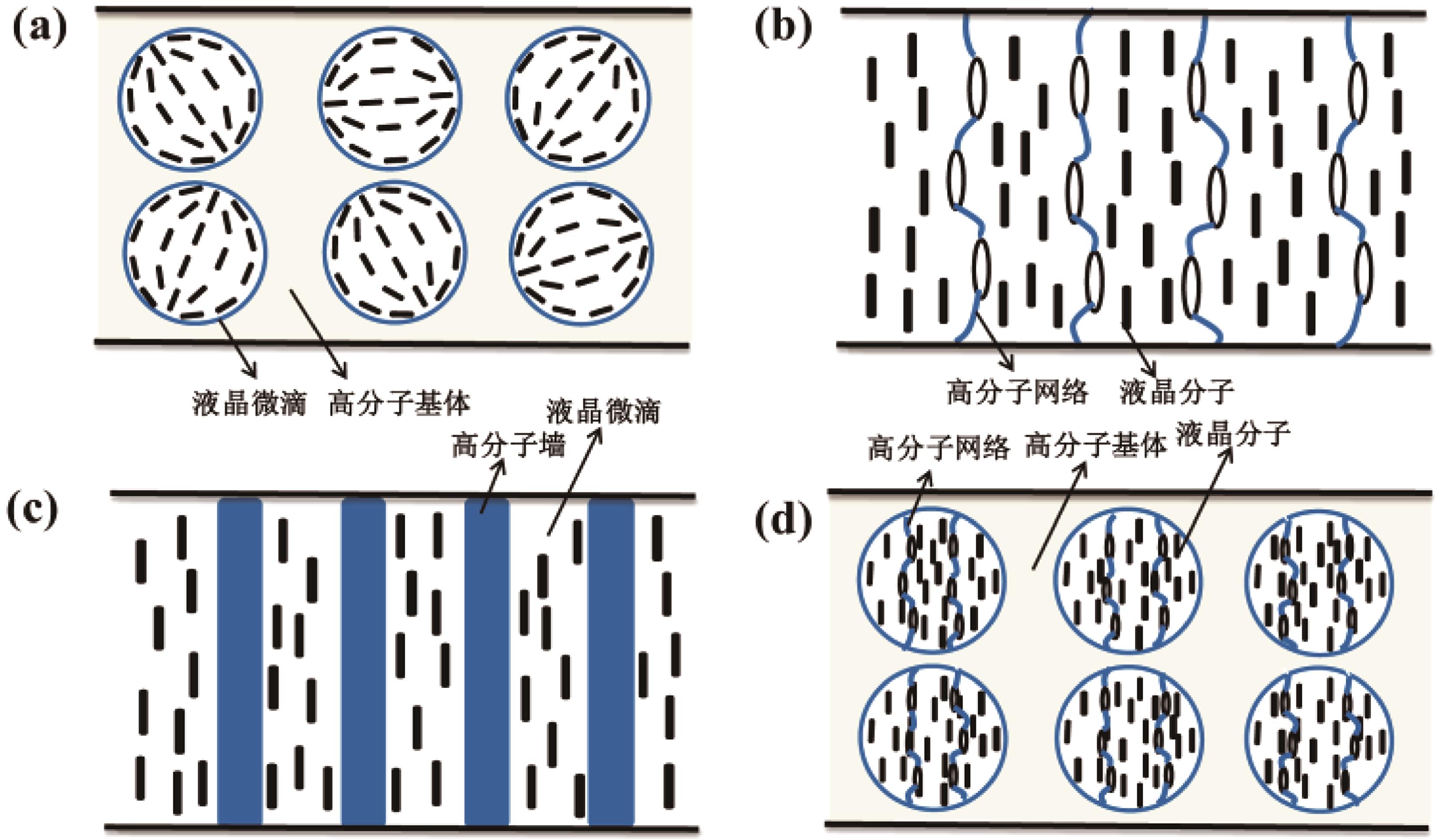
图1 不同类型的液晶/高分子复合材料微结构示意图: (a)高分子分散液晶,(b)高分子稳定液晶,(c)高分子墙稳定液晶,(d)高分子分散和稳定液晶共存体系
Fig.1 Schematic representation of the microstructures for different types of liquid crystal/polymer composites: (a) polymer-dispersed liquid crystals, (b) polymer-stabilized liquid crystals, (c) polymer-wall-stabilized liquid crystals, (d) polymer-dispersed & -stabilized liquid crystals
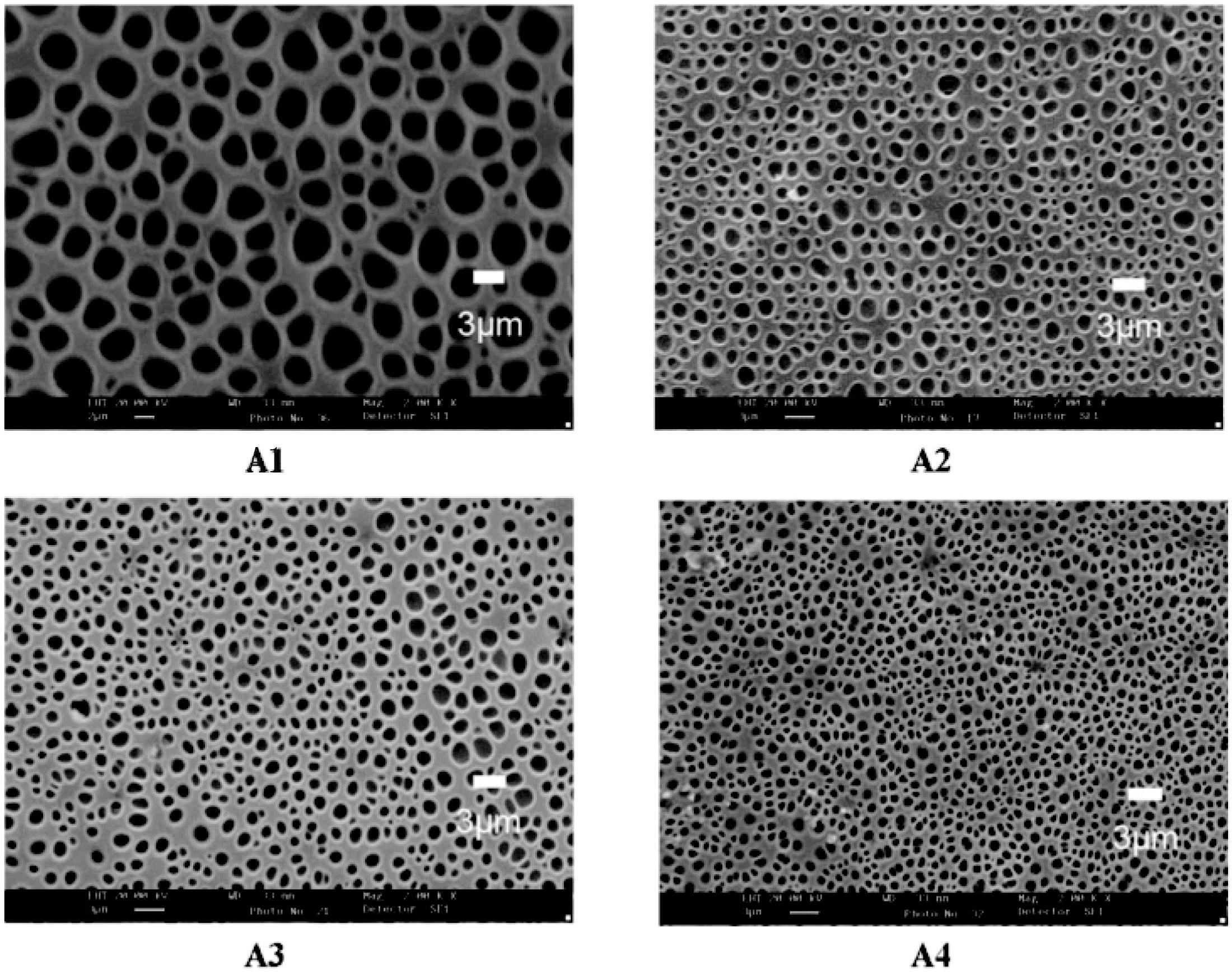
图2 PDLC样品典型的扫描电子显微镜俯视照片[23]: A1—A4为具有不同双官能度和三官能度环氧单体配比的样品
Fig.2 Typical scanning electron microscope (SEM) images of PDLC[23]: A1—A4 were samples with different proportions of difunctional and trifunctional epoxy monomers
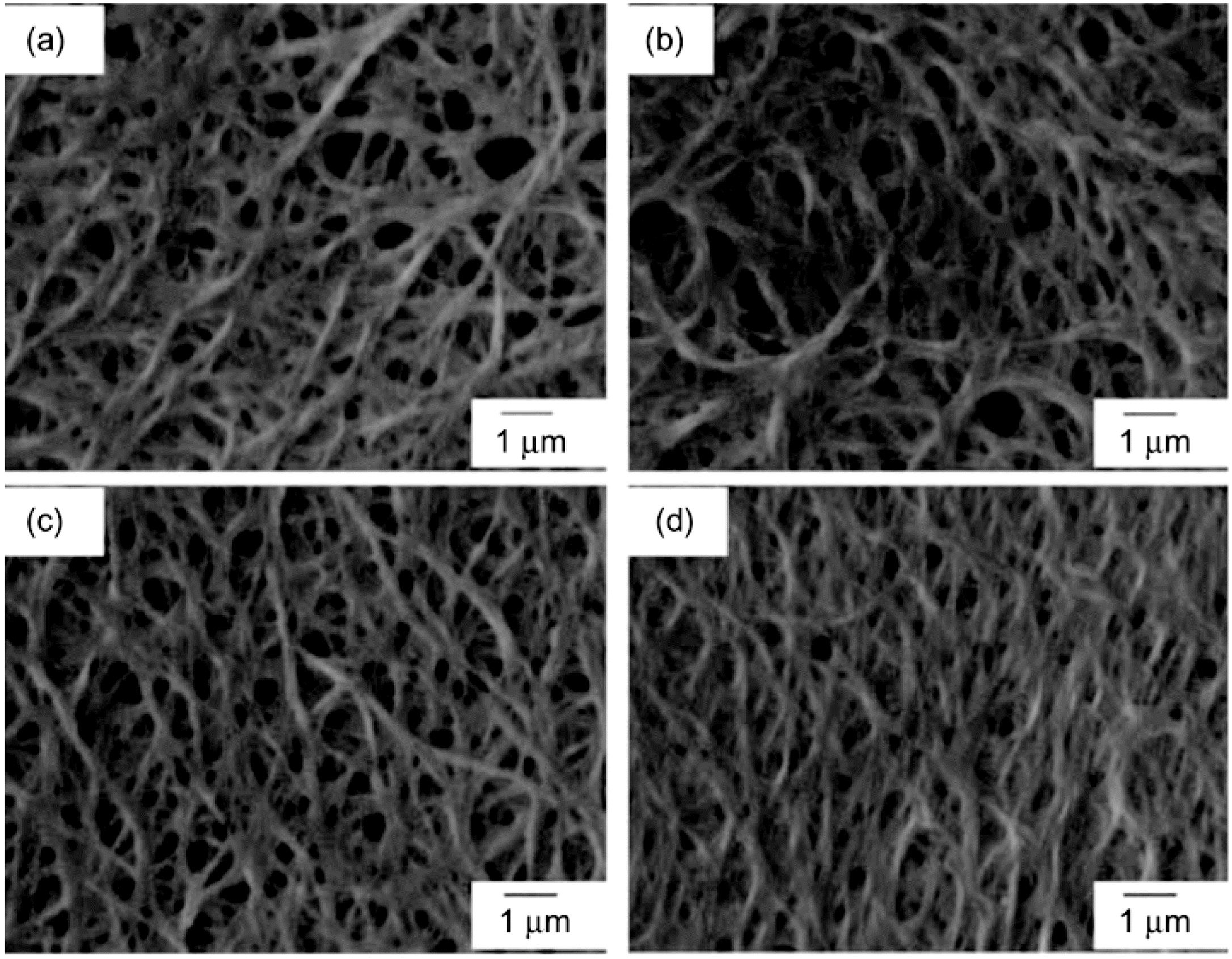
图3 PSLC样品典型的扫描电子显微镜俯视照片[25]:(a)—(d)为具有相同螺距但含有不同分子结构的手性掺杂剂的样品
Fig. 3 Typical SEM images of PSLC[25]: (a)—(d) were samples with different chiral dopants in the same pitch
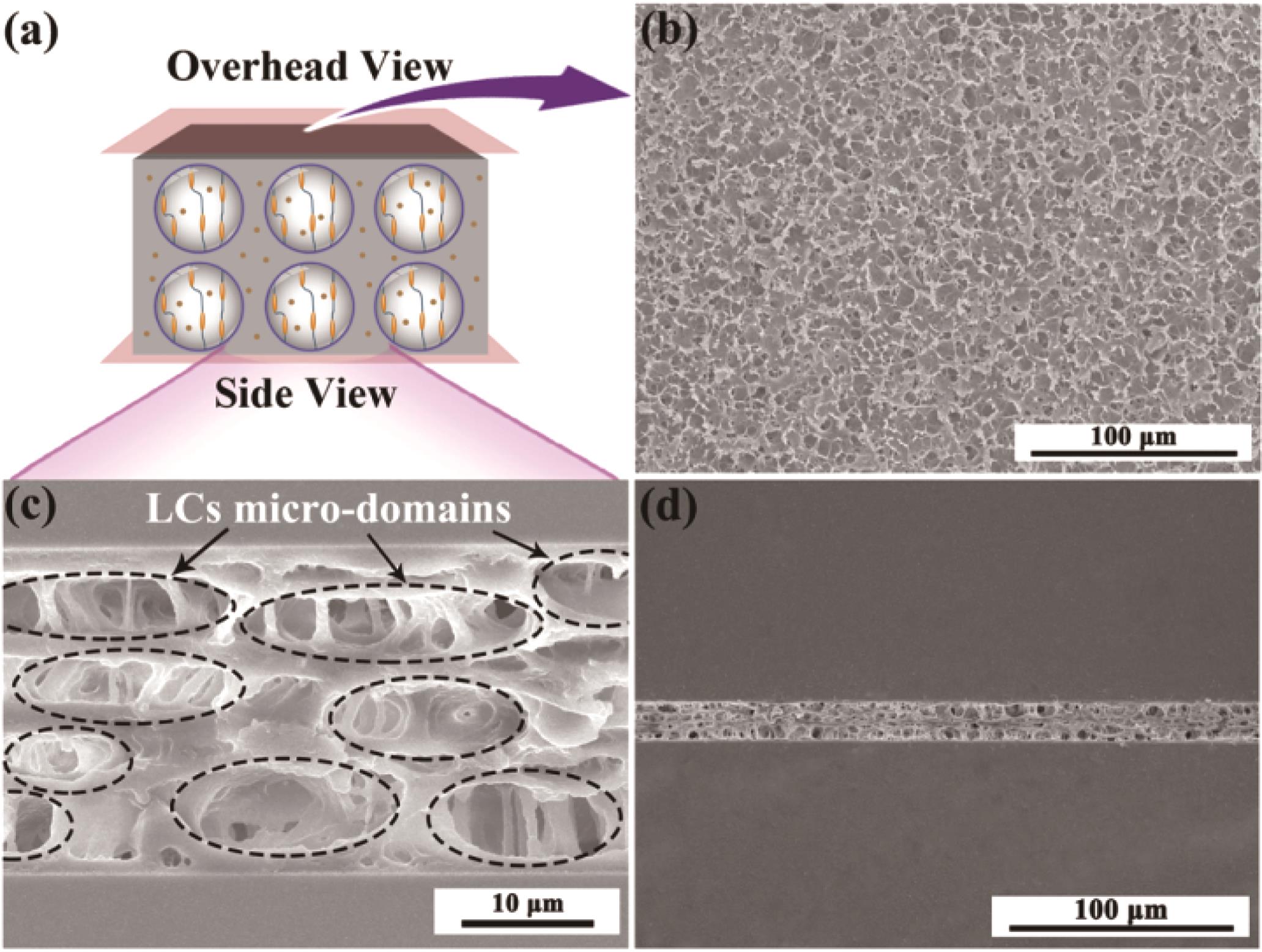
图5 PD&SLC典型的电子显微镜照片[32]: (a)结构示意图;(b)扫描电子显微镜俯视照片;(c)高分子微结构的扫描电子显微镜侧视照片;(d)薄膜的扫描电子显微镜侧视照片
Fig.5 Typical SEM images of PD&SLC[32]: (a) schematic representation of the microstructure, (b) top-view SEM image of the film, (c) side-view SEM image of the polymer microstructure, (d) side-view SEM image of the film

图6 液晶/高分子复合材料的扫描电子显微镜侧视图[19](a)PDLC薄膜; (b)PSLC薄膜; (c)高分子分散与稳定液晶共存体系薄膜
Fig. 6 Typical side-view SEM images of liquid crystal/polymer composites[19](a) PDLC; (b) PSLC; (c) PD&SLC
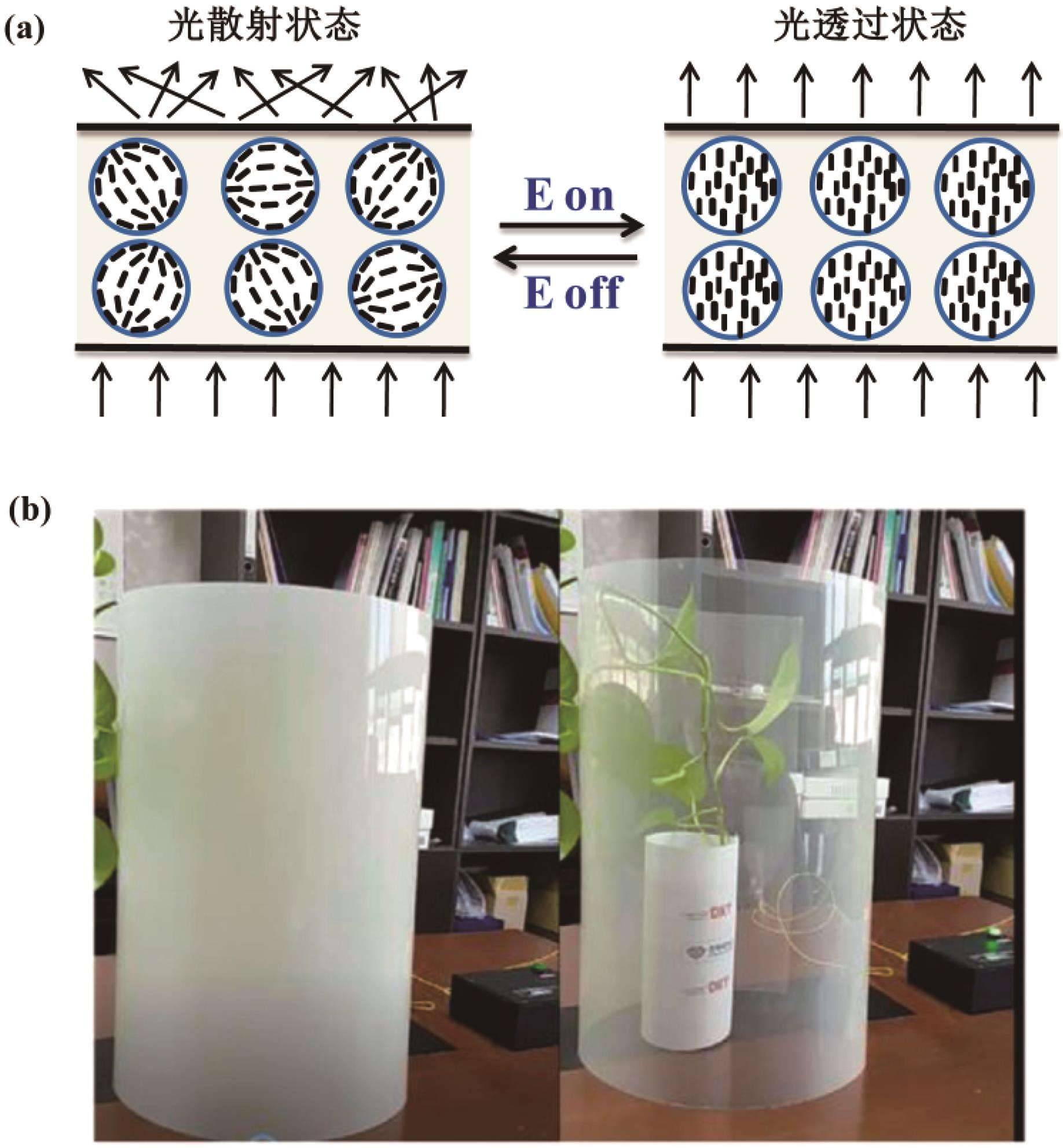
图7 基于PDLC的正式调光膜(a)原理示意图及(b)实物照片[40]
Fig.7 (a) Schematic diagram and (b) photographs of the normal-mode electrically switchable light-transmittance controllable film[40]
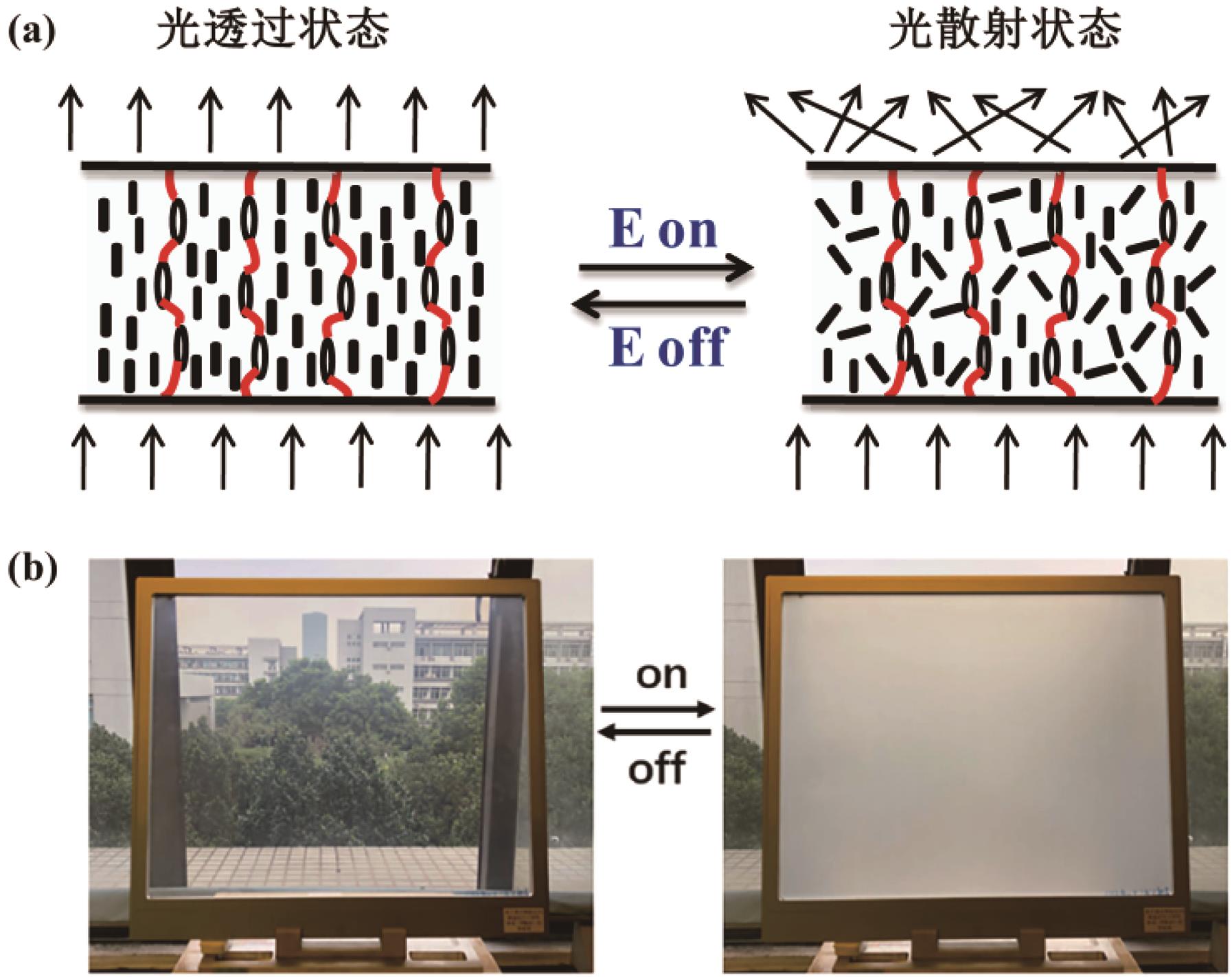
图8 一种基于PSLC材料的反式电控调光膜 (a)原理示意图及(b)实物照片[36]
Fig.8 (a) Schematic diagram and (b) photographs of the reverse-mode electrically switchable light-transmittance controllable film[36]

图9 (a)基于负性向列相液晶的反式调光膜工作原理图, (b)薄膜实物图, (c)样品透过率和雾度随电压变化曲线, (d)样品在关闭电场和施加电场时的偏光照片[36]
Fig.9 (a) Schematic diagram, (b) photographs, (c) transmittance and haze dependence on electric-field intensity and (d) polarized optical microscope images of the reverse-mode film based on nematic liquid crystals with negative dielectric anisotropy[36]

图12 基于内建电场的反式PDLC电荷分布示意图[50]: (a)采用高导电液晶、(b)采用高导电聚合物基体和(c)离子嵌入液晶/高分子基体界面时的内建电场(Edc)方向及电荷分布示意图
Fig.12 Schematic diagram of the charge distribution in the reverse-mode PDLC based on built-in electric fields[50]: built-in DC electric field (Edc) across the film with (a) a highly conductive liquid crystal, (b) a highly conductive polymer matrix, (c) ions frozen in the liquid crystal/polymer interface
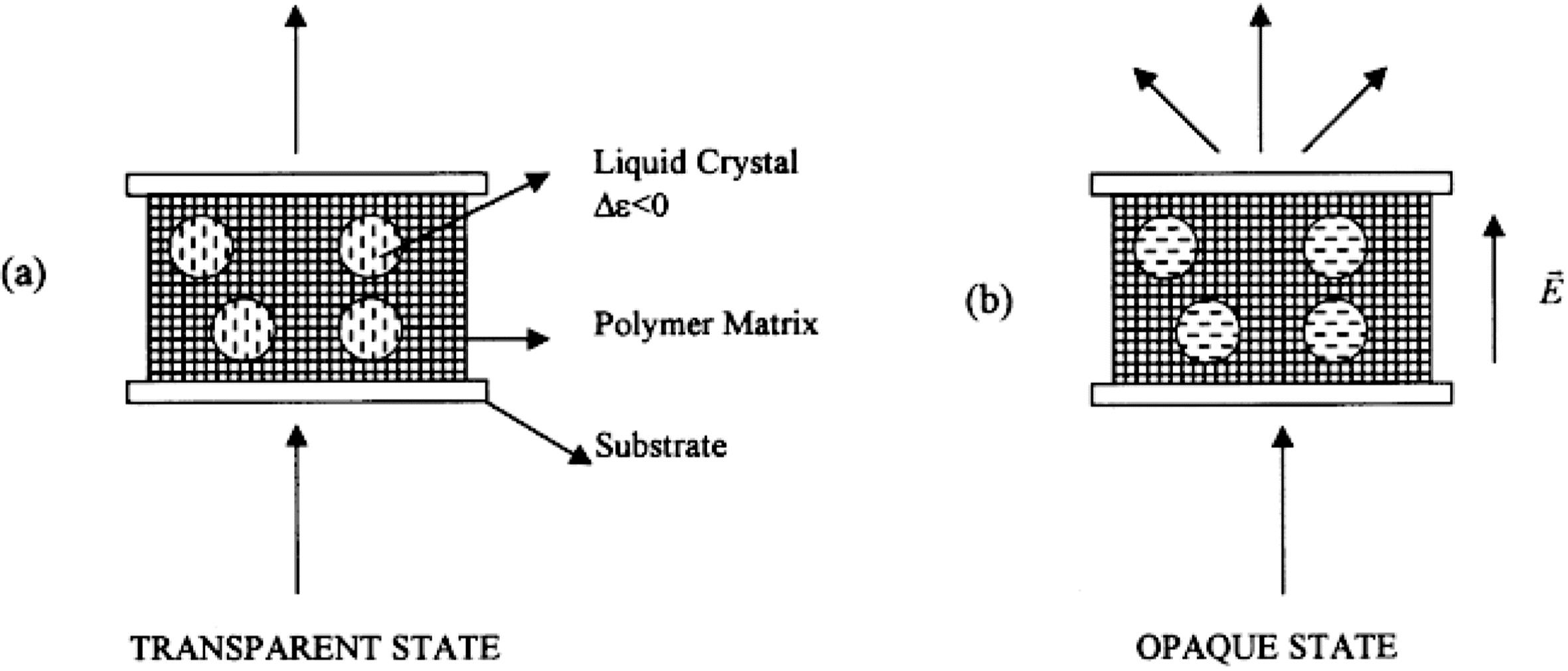
图13 热诱导和紫外聚合分步相分离制备的反式调光膜工作原理示意图[51]
Fig.13 Schematic diagram of the reverse-mode PDLC prepared by a thermal induced and UV polymerization induced two-step phase separation method[51]

图15 (a)—(d)紫外分步聚合制备PD&PSLC示意图,(e)制备PD&SLC所使用的分子结构示意图[55]
Fig.15 (a)—(d) Schematic diagram of a two-step UV polymerization route for making the PD&PSLC film and (e) some of the chemical structures and physical properties of the reagents used in the study[55]

图16 (a)商用PDLC和所制备的分别含有质量分数0 %、0.5 %、1.0 %和2.0 % 液晶性可聚合单体的薄膜的剪切力-位移曲线,(b)展示薄膜柔韧性和稳健性的照片:图中E代表电场,LE代表低频电场,HE代表高频电场[55]
Fig.16 (a) Shearing force-displacement curves of the commercial PDLCs and the as-made LCs/PCs containing 0 %, 0.5 %, 1.0 % and 2.0 % (mass percent)LCPMs, respectively. (b) Digital photographs demonstrating the flexibility and robustness of the as-made LCs/PC:in the diagram E is short for electric field, LE is short for low-frequency electric field, HE is short for high-frequency electric field[55]
| 1 | WHITE T J, BROER D J. Programmable and adaptive mechanics with liquid crystal polymer networks and elastomers[J]. Nat Mater, 2015, 14(11): 1087-1098. |
| 2 | SAEED M H, ZHANG S, CAO Y, et al. Recent advances in the polymer dispersed liquid crystal composite and its applications[J]. Molecules, 2020, 25(23): 5510. |
| 3 | DOANE J W, VAZ N A, WU B G, et al. Field controlled light scattering from nematic microdroplets[J]. Appl Phys Lett, 1986, 48(4): 269-271. |
| 4 | CHIDICHIMO G, BENEDUCI A, MALTESE V, et al. 2D/3D switchable displays through PDLC reverse mode parallax barrier[J]. Liq Cryst, 2018, 45(13/14/15): 2132-2138. |
| 5 | LIU S, LI Y, ZHOU P, et al. Reverse-mode PSLC multi-plane optical see-through display for AR applications[J]. Opt Express, 2018, 26(3): 3394. |
| 6 | LIANG X, CHEN M, WANG Q, et al. Active and passive modulation of solar light transmittance in a hybrid thermochromic soft-matter system for energy-saving smart window applications[J]. J Mater Chem C, 2018, 6(26): 7054-7062. |
| 7 | DE SIO L, LLOYD P F, TABIRYAN N V, et al. Thermoplasmonic activated reverse-mode liquid crystal gratings[J]. ACS Appl Nano Mater, 2019, 2(5): 3315-3322. |
| 8 | SUN J, WU S. Recent advances in polymer network liquid crystal spatial light modulators[J]. J Polym Sci, Part B: Polym Phys, 2014, 52(3): 183-192. |
| 9 | REN H, FAN Y, GAUZA S, et al. Tunable microlens arrays using polymer network liquid crystal[J]. Opt Commun, 2004, 230(4/5/6): 267-271. |
| 10 | XIONG G, HAN G, SUN C, et al. Phototunable microlens array based on polymer dispersed liquid crystals[J]. Adv Funct Mater, 2009, 19(7): 1082-1086. |
| 11 | ZHANG S, LI C, WANG Q, et al. Fluorescence enhancement and encapsulation of quantum dots via a novel crosslinked vinyl-ether liquid crystals/polymer composite film[J]. Polymer, 2020, 207: 122834. |
| 12 | ZHOU L, CHEN G, SHEN W, et al. Effect of functionality of thiol on the optical properties of liquid crystals/polymer composite films[J]. Liq Cryst, 2021, 48(3): 313-321. |
| 13 | ZHOU L, HE Z, HAN C, et al. Switchable anti-peeping film for liquid crystal displays from polymer dispersed liquid crystals[J]. Liq Cryst, 2019, 46(5): 718-724. |
| 14 | KAKIUCHIDA H, MATSUYAMA A, OGIWARA A. Normal- and reverse-mode thermoresponsive controllability in optical attenuation of polymer network liquid crystals[J]. ACS Appl Mater Interfaces, 2019, 11(21): 19404-19412. |
| 15 | DIERKING I. Polymer network-stabilized liquid crystals[J]. Adv Mater, 2000, 12(3): 167-181. |
| 16 | KIKUCHI H, YAMAMOTO H, SATO H, et al. Formation of polymer-wall-stabilized bend-mode liquid crystal cells[J]. J Photopolym Sci Technol, 2003, 16(2): 181-186. |
| 17 | GHEORGHIU N, WEST J L, GLUSHCHENKO A V, et al. Patterned field induced polymer walls for smectic A bistable flexible displays[J]. Appl Phys Lett, 2006, 88(26): 263511. |
| 18 | GUO S, LIANG X, ZHANG H, et al. An electrically light-transmittance-controllable film with a low-driving voltage from a coexistent system of polymer-dispersed and polymer-stabilised cholesteric liquid crystals[J]. Liq Cryst, 2018, 45(12): 1854-1860. |
| 19 | GUO S, LIANG X, ZHANG C, et al. Preparation of a thermally light-transmittance-controllable film from a coexistent system of polymer-dispersed and polymer-stabilized liquid crystals[J]. ACS Appl Mater Interfaces, 2017, 9(3): 2942-2947. |
| 20 | LIANG X, GUO S, CHEN M, et al. A temperature and electric field-responsive flexible smart film with full broadband optical modulation[J]. Mater Horizons, 2017, 4(5): 878-884. |
| 21 | NICOLETTA F P, CHIDICHIMO G, CUPELLI D, et al. Electrochromic polymer-dispersed liquid-crystal film: a new bifunctional device[J]. Adv Funct Mater, 2005, 15(6): 995-999. |
| 22 | MENG Q, CAO H, KASHIMA M, et al. Effects of the structures of epoxy monomers on the electro-optical properties of heat-cured polymer-dispersed liquid crystal films[J]. Liq Cryst, 2010, 37(2): 189-193. |
| 23 | ZHANG T, KASHIMA M, ZHANG M, et al. Effects of the functionality of epoxy monomer on the electro-optical properties of thermally-cured polymer dispersed liquid crystal films[J]. RSC Adv, 2012, 2(5): 2144-2148. |
| 24 | ZHANG C, WANG D, CAO H, et al. Preparation and electro-optical properties of polymer dispersed liquid crystal films with relatively low liquid crystal content[J]. Polym Adv Technol, 2013, 24(5): 453-459. |
| 25 | LU H, SONG Z, ZHANG J, et al. The influence of helical twisting power on the electro-optical properties of reverse-mode polymer-stabilised cholesteric texture[J]. Liq Cryst, 2014, 41(4): 615-620. |
| 26 | YU H H, HWANG S J, CHEN R L, et al. Study of the purifying affects of thermal annealing for polymer-wall liquid crystal cells[J]. Liq Cryst, 2008, 35(12): 1339-1343. |
| 27 | WU S, FUH A Y. Two-dimensional diffraction grating based on polymer-dispersed liquid crystals[J]. Jpn J Appl Phys, 2004, 43(10): 7077-7082. |
| 28 | SONG D H, LEE S R, YOON T, et al. Multi-dimensional liquid crystal alignment effect of polymer wall on vertically aligned liquid crystal cell[J]. Jpn J Appl Phys, 2010, 49(1): 11702. |
| 29 | LEE Y, JANG S, JUNG J, et al. Mechanical stability of pixel-isolated liquid crystal mode for flexible display application[J]. Mol Cryst Liq Cryst, 2006, 458(1): 81-87. |
| 30 | ZHENG W, LEE M C. Attainment of planarly aligned liquid crystal using vertical alignment polymer walls[J]. Mol Cryst Liq Cryst, 2012, 553(1): 28-35. |
| 31 | KIKUCHI H, YAMAMOTO H, SATO H, et al. Bend-mode liquid crystal cells stabilized by aligned polymer walls[J]. Jpn J Appl Phys, 2005, 44(2): 981-989. |
| 32 | LIANG X, CHEN M, GUO S, et al. Dual-band modulation of visible and near-infrared light transmittance in an all-solution-processed hybrid micro-nano composite film[J]. ACS Appl Mater Interfaces, 2017, 9(46): 40810-40819. |
| 33 | BARILE C J, SLOTCAVAGE D J, HOU J, et al. Dynamic windows with neutral color, high contrast, and excellent durability using reversible metal electrodeposition[J]. Joule, 2017, 1(1): 133-145. |
| 34 | MENG C, TSENG M C, TANG S T, et al. Normally transparent smart window with haze enhancement via inhomogeneous alignment surface[J]. Liq Cryst, 2019, 46(3): 484-491. |
| 35 | GRANQVIST C. Electrochromic materials: out of a niche[J]. Nat Mater, 2006, 5(2): 89. |
| 36 | HU X, ZHANG X, YANG W, et al. Stable and scalable smart window based on polymer stabilized liquid crystals[J]. J Appl Polym Sci, 2020: 48917. |
| 37 | ZHAO R, LI X, WANG K, et al. Effect of the introduction of mono-functional monomer on the electro-optic properties of reverse-mode polymer stabilised cholesteric liquid crystal[J]. Liq Cryst, 2021, 48(8): 1162-1174. |
| 38 | YANG D K, CHIEN L C, DOANE J W. Cholesteric liquid crystal/polymer dispersion for haze-free light shutters[J]. Appl Phys Lett, 1992, 60(25): 3102-3104. |
| 39 | 吴琴. 正反向调光膜性能及应用研究[J]. 中国高新科技, 2019(1): 107-109. |
| WU Q. Normal- and reverse-mode light-transmittance controllable films and their applications[J]. Zhong Guo Gao Xin Ke Ji, 2019(1): 107-109. | |
| 40 | KIM D, HWANG D Y, PARK J, et al. Liquid crystal-based flexible smart windows on roll-to-roll slot die-coated Ag nanowire network films[J]. J Alloys Compd, 2018, 765: 1090-1098. |
| 41 | REN H, WU S. Reflective reversed-mode polymer stabilized cholesteric texture light switches[J]. J Appl Phys, 2002, 92(2): 797-800. |
| 42 | HIKMET R A M. Electrically induced light scattering from anisotropic gels[J]. J Appl Phys, 1990, 68(9): 4406-4412. |
| 43 | MURAI H, GOTOH T, NAKATA T, et al. Homeotropic reverse-mode polymer-liquid crystal device[J]. J Appl Phys, 1997, 81(4): 1962-1965. |
| 44 | MACCHIONE M, CUPELLI D, FILPO G D, et al. Rough surfaces for orientation control in reverse mode polymer dispersed liquid crystal films[J]. Liq Cryst, 2000, 27(7): 917-920. |
| 45 | HIKMET R A M, ZWERVER B H. Structure of cholesteric gels and their electrically induced light scattering and colour changes[J]. Liq Cryst, 1992, 12(2): 319-336. |
| 46 | AHMAD F, JAMIL M, JEON Y J. Reverse mode polymer stabilized cholesteric texture (PSCT) light shutter display—a short review[J]. J Mol Liq, 2017, 233: 187-196. |
| 47 | NOLAN P, COATES D. Reverse mode polymer dispersed liquid crystal display incorporating a dual frequency addressable liquid crystal mixture[J]. Mol Cryst Liq Cryst Lett, 1991, 8(4): 75-83. |
| 48 | FAN Y, REN H, LIANG X, et al. Dual-frequency liquid crystal gels with submillisecond response time[J]. Appl Phys Lett, 2004, 85(13): 2451-2453. |
| 49 | WEN C, WU S. Dielectric heating effects of dual-frequency liquid crystals[J]. Appl Phys Lett, 2005, 86(23): 231104. |
| 50 | CUPELLI D, NICOLETTA F P, DE FILPO G, et al. Reverse mode operation polymer dispersed liquid crystal with a positive dielectric anisotropy liquid crystal[J]. J Polym Sci, Part B: Polym Phys, 2011, 49(4): 257-262. |
| 51 | NICOLETTA F P, DE FILPO G, LANZO J, et al. A method to produce reverse-mode polymer-dispersed liquid-crystal shutters[J]. Appl Phys Lett, 1999, 74(26): 3945-3947. |
| 52 | NICOLETTA F P, CARUSO C, DE FILPO G, et al. Electric, electro-optical, and morphological properties of two-step-polymerization PDLC[J]. Proc SPIE-Int Soc Opt Eng, 1998, 3319:285-288. |
| 53 | WANG H, GONG H, SONG P, et al. Reverse-mode polymer dispersed liquid crystal films prepared by patterned polymer walls[J]. Liq Cryst, 2015, 42(9): 1320-1328. |
| 54 | SHIN Y, OH N, KWON S. Electro-optical properties of normally transparent polymer dispersed liquid crystal cells with polymer wall and network structure[J]. Mol Cryst Liq Cryst, 2017, 647(1): 415-421. |
| 55 | LIANG X, CHEN M, GUO S, et al. Programmable electro-optical performances in a dual-frequency liquid crystals/ polymer composite system[J]. Polymer, 2018, 149: 164-168. |
| [1] | 陶雨晨, 候晓慧, 尹登科, 杨晔. 基于电场调控的胆固醇基液晶薄膜对成纤维细胞生长分化的影响[J]. 应用化学, 2023, 40(4): 546-553. |
| [2] | 刘也, 郭少波, 梁艳莉, 葛红光, 马剑琪, 刘智峰, 刘波. 核壳型纳米复合材料CuFe2O4@NH2@Pt的制备及催化性能[J]. 应用化学, 2022, 39(8): 1237-1245. |
| [3] | 曹从军, 马含笑, 侯成敏, 丁小健, 管飙. 乙基纤维素磁性复合材料对溶液中铜离子的吸附性能[J]. 应用化学, 2022, 39(6): 969-979. |
| [4] | 张晨晨, 刘昱含, 赵文杰, 刘佰军, 孙昭艳, 刘万利, 王艳淼, 呼微. 氧化有机溶剂木质素基亲水性上浆剂的制备及其在聚丙烯中的应用[J]. 应用化学, 2022, 39(12): 1854-1861. |
| [5] | 周玉凤, 周川巍, 胡桐泽, 段展鹏, 王颢潼, 石淑云. Fe/V-Sb2O3复合材料的构筑及光催化降解医药废水[J]. 应用化学, 2022, 39(10): 1572-1578. |
| [6] | 史和昌, 于彦存, 韩常玉. 聚乙烯/氧化铝复合材料形态、流变和力学性能[J]. 应用化学, 2022, 39(10): 1593-1599. |
| [7] | 李祎, 程宏达, 于彦存, 韩常玉, 陈广建, 祝英男. 高密度聚乙烯复合导热材料性能[J]. 应用化学, 2021, 38(8): 954-960. |
| [8] | 潘勇, 齐延新, 李晓媛, 黄宇彬. 基于高分子的疫苗递送系统构建和应用[J]. 应用化学, 2021, 38(5): 582-591. |
| [9] | 程广增, 刘帅, 王焕磊. 钾离子电池负极的高性能潜在材料:锑[J]. 应用化学, 2021, 38(2): 170-180. |
| [10] | 赵云萧, 王光鑫, 陈友绪, 赵桂艳. 聚合物/淀粉复合材料的制备与性能研究进展[J]. 应用化学, 2021, 38(11): 1432-1440. |
| [11] | 纪宇帆, 蔡锋, 于海峰. 液晶聚合物的表面形貌光调控研究进展[J]. 应用化学, 2021, 38(10): 1226-1237. |
| [12] | 罗龙飞, 李玉洁, 沈志豪, 郑世军, 范星河. 偶氮苯液晶嵌段共聚物薄膜自组装和光响应性研究进展[J]. 应用化学, 2021, 38(10): 1238-1254. |
| [13] | 陈爱华, 张承鋆, 邓子超, 孙亚兰. 液晶嵌段共聚物液相自组装体的结构调控[J]. 应用化学, 2021, 38(10): 1255-1267. |
| [14] | 王丹, 彭海炎, 周兴平, 解孝林. 全息高分子/液晶复合材料的研究进展[J]. 应用化学, 2021, 38(10): 1268-1298. |
| [15] | 张帅, 杨洋, 吉岩, 危岩. 磁响应液晶弹性体材料研究进展[J]. 应用化学, 2021, 38(10): 1299-1309. |
| 阅读次数 | ||||||
|
全文 |
|
|||||
|
摘要 |
|
|||||
